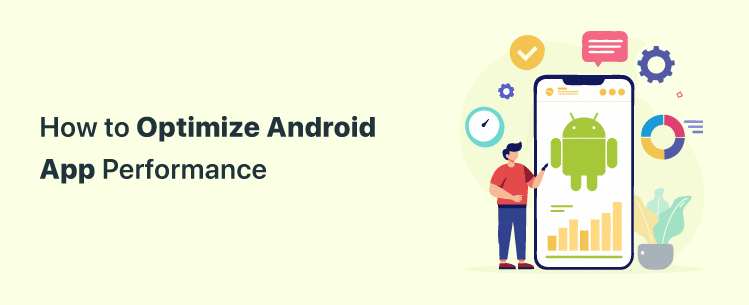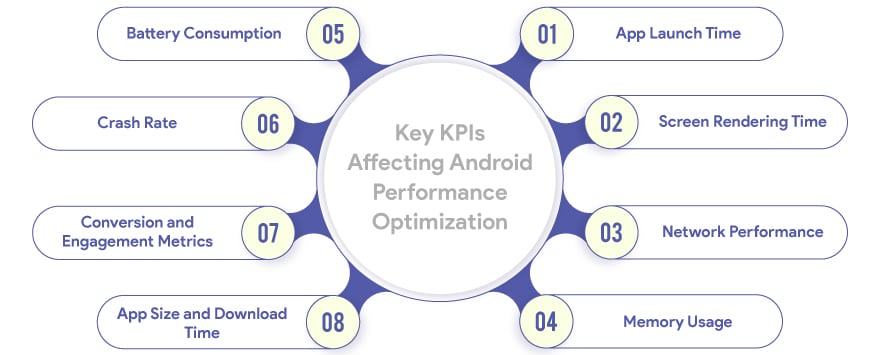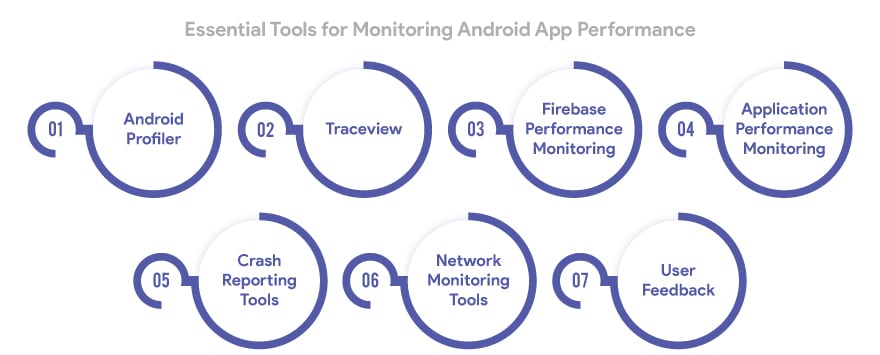
Introduction
Are you wondering what aspect of app creation is most important?
The answer is the performance of your Android app. Yes, Android devices have several cores, making it extremely challenging to develop lag-free Android apps. The opposite is true.
Android offers various features and customization options; choosing which is the hardest part. Knowing the inner workings of an Android app is essential if you want to improve its performance. Fortunately, various tools are available to help you identify bottlenecks, demonstrate their effects, and quantify them.
If you want your Android app to be successful, you need to know how to boost its performance, not just rely on your instincts or hope for the best.
Key KPIs Affecting Android Performance Optimization in 2024
Optimizing performance is crucial to success. Key Performance Indicators (KPIs) are essential metrics that help measure and improve your app’s performance. Organizations can gain insights and make data-driven decisions to enhance user experience by tracking these KPIs. Here are some critical KPIs to consider for app performance optimization:
1. App Launch Time:
This measure measures how quickly the app becomes usable after launch, reflecting how fast users can interact. A shorter launch time is vital for delivering a smooth user experience.
2. Screen Rendering Time:
This tracks the time for UI elements and content to appear on the screen. Optimizing this ensures the app feels responsive and lag-free when navigating between screens.
3. Network Performance:
Includes latency, response time, and data transfer rate metrics. Optimizing these ensures efficient server communication and smooth data loading, even in varying network conditions.
4. Memory Usage:
Monitoring memory consumption is key to preventing memory leaks and excessive usage. KPIs like memory footprint, allocation rate, and peak usage ensure the app performs well without crashes or slowdowns.
5. Battery Consumption:
Measures the app’s impact on battery life. Optimizing this ensures the app doesn’t excessively drain the battery, which can otherwise lead to a poor user experience and decreased device performance.
6. Crash Rate:
Tracks how often the app crashes. Reducing the crash rate is essential for user satisfaction, as frequent crashes can lead to negative reviews or uninstallation. Regularly monitoring and addressing crash reports is vital for maintaining app stability.
7. Conversion and Engagement Metrics:
This metric focuses on user interaction and engagement, including retention rates, session duration, and conversion rates like sign-ups and purchases. These metrics highlight the app’s effectiveness in driving user engagement and achieving business goals.
8. App Size and Download Time:
Smaller app sizes and faster download times are important for user acquisition and retention, especially in regions with limited bandwidth. Monitoring these metrics and reducing app size can significantly enhance user experience.

Why is mobile app performance important?
The world is becoming increasingly digital, making it imperative for companies to deliver seamless digital experiences. Users have high expectations for applications and have little tolerance for those that perform poorly.
App crashes are the primary cause of app uninstallations (71%). If an app takes too long to load, 70% of users will uninstall it. These numbers are typical and portray a very obvious picture: mobile app performance must be a top priority. You risk losing customers and money if there is no obvious method to improve your mobile app’s performance.
The ultimate measure of your mobile app’s success is the satisfaction of its users. If a user has a negative experience with your app, you may have lost them forever. Poor performance is the number one reason why apps fail in every sector. You need to pay close attention to the functionality of your mobile app if you want satisfied customers.
When your app functions well, users will be more invested and willing to spend more money. According to several studies, the longer a page takes to load, the higher the conversion rate. Your mobile app’s performance directly affects your conversion rate, so it should be a top priority in your company plan.
Android App Performance Optimization: Essential Steps for Success
Compress Your Application
An Android app’s performance may improve on devices with constrained storage if the app is smaller. When an app is smaller, it takes more time to download and may lose users. Developers can implement these recommended practices to decrease the size of an Android app:
- Implement Code Shrinkage: Code shrinkage is the process of lowering the size of an app by removing unneeded code and resources. Developers can utilize programs like ProGuard and R8 to reduce their code size.
- Apply resource shrinking, which removes unwanted assets in a program and makes it smaller. To reduce the size of files, developers can utilize the Android Asset Packaging Tool (AAPT) or the Android Gradle plugin.
- Use APK Splitting, which divides a large APK into many smaller APKs, each with only the code and data necessary to run on a certain type of device. This could reduce the size of APKs consumers have to download.
- By employing data compression techniques, developers may make their apps smaller, and data transfers faster. A compression library, such as Zlib, or compressing media files can help.
- Developers may minimize their apps’ size without compromising content quality by optimizing resources like photos and videos. Tools for picture compression, resizing, and format conversions are all viable options here.
- Using dynamic feature modules, programmers may distribute app functionalities independently. This can help keep app sizes down by letting consumers download only the functionality they’ll utilize.
Minimize Activity Leak
In Android apps, memory leaks and poor performance can result from improper activity management, known as “activity leaks.” These best can help developers reduce activity leaks:
- Don’t forget to free up views and adapters when you kill an activity. Please do so to avoid memory leaks and poor performance in your program. The onDestroy() function allows developers to free up resources used by an activity.
- Avoid memory leaks by only using weak references; strong references prohibit objects within an activity from being garbage collected. To avoid this, developers might make use of weak references.
- Refrain from relying on past citations: Memory leaks can occur if activities are not garbage collected because of static references to them. Programmers shouldn’t rely on hard coded references to activities.
- If you need to do something that would prevent an activity from being trash collected, utilize the Application context instead of the Activity context. Instead, they may use the Application context, which is persistent for the app’s execution.
- Memory profilers are useful tools for finding and fixing memory and activity leaks in software. Developers may remedy issues that slow down their apps by monitoring how much memory they’re using.
Improve the Speed of Android’s Encryption
Encryption is a must-have safety feature when protecting private information in Android apps. However, encryption can slow down apps, especially on less powerful mobile devices. Android developers may improve encryption speed by adhering to these guidelines.
- By moving the encryption and decryption processes to specific hardware components, hardware encryption may greatly boost encryption performance. The Android Keystore System allows programmers to utilize hardware encryption in their software.
- Choose effective encryption methods; not all methods achieve the same levels of security. Better encryption performance is possible with some algorithms, such as AES. When building encrypted apps, developers should use strong encryption techniques.
- Use encryption just when necessary; developers shouldn’t encrypt everything. Too much data encryption, especially of innocuous data, might have an undesirable effect on app performance.
- Key management is crucial to encryption but can harm app performance if not optimized. Optimizing key management requires developers to apply key derivation functions, restrict the total amount of keys in use, and store keys in a safe place.
- To find performance issues and optimize the encryption in their apps, developers should assess their performance. It’s possible to gauge how encryption affects other app features and how long it takes to encrypt and decode data.
Consider Low-configuration Device
An app’s performance may suffer on low-configuration devices like older or less expensive Android smartphones because of their slower CPUs and less memory. By adhering to these guidelines, developers can improve app performance on low-configuration smartphones.
- To find performance issues and places to improve, developers should test their apps on low-configuration devices.
- Reduce the app’s initialization time to improve its perceived performance. Delaying non-critical initialization till after the program has begun might help developers optimize startup time by lowering the amount of the first activity.
- If you want your app to run well on low-configuration devices, you should use data structures and algorithms that minimize memory and processing needs.
- Reduce the number of network queries your program makes, as these might be particularly sluggish on low-configuration devices. These techniques include data caching, compression, and size reduction during transmission.
- Graphics and animations may be quite resource-intensive, especially on low-configuration devices. Thus, it’s important to optimize them. For optimal performance, reduce images and animations’ file size, frame rate, and complexity.
- Please use flexible layouts, which let apps change their design to various display sizes and resolutions. This can assist in making sure the program works with minimal hardware requirements.
Avoid Deprecation
Deprecation in Android development is designating a feature, class, or method as unsupported and discouraging its use. However, future versions of Android may eliminate support for or deprecate these functionalities altogether.
Developers should avoid deprecated features and use the suggested alternatives to optimize app performance and guarantee future compatibility. The following are some recommendations for Android developers to follow to prevent deprecation:
- Keep current with the newest Android releases: Developers should always use the most recent Android version and its release notes to learn about deprecated functionality and suggested alternatives.
- Make use of the Android Compatibility Library: Because of the Android Compatibility Library, developers may use the newest features while still maintaining support for earlier versions of Android.
- Use compatible libraries. Instead of relying on obsolete features, you may use one of the many compatible libraries available for Android development. Developers may consider adopting these libraries as an alternative to these outdated capabilities.
- If an app already makes use of a deprecated feature, developers should modify the app’s code such that it makes use of the recommended replacements.
- Developers should run their apps through a battery of tests on a wide range of devices and Android versions to check for compatibility and spot problems caused by deprecated functionality.
For more advanced optimizations and app development needs, partnering with a professional android app development company can be a great option.
Optimize Offline Mode
To enhance the performance of an Android app in 2024, particularly in offline mode, consider these strategies:
- Implement smart caching to minimize network traffic. Store frequently used data locally, making network calls only when essential.
- This feature allows users to interact with app features even when offline. Users store their inputs locally and sync with the server once they are online.
- Use efficient databases like SQLite or Room for local storage. Optimize how data is stored and retrieved to improve performance.
- Use background services like WorkManager to sync data without interrupting the user experience.
- Optimize memory and CPU usage. Manage object references properly to prevent memory leaks and improve image loading with compression and caching.
- Anticipate user actions by preloading relevant data, reducing load times, and enhancing user experience.
- Effectively manage network changes using broadcast receivers. Keep users informed of connectivity status and provide offline access where possible.
Optimize Frame Rate
- Enable hardware acceleration to leverage the GPU for smoother animations and higher frame rates.
- Streamline the rendering process by reducing draw calls and overdraw. Use batching, texture atlases, and occlusion culling to reduce GPU workload.
- Avoid unnecessary rendering of pixels by using tools like Android Studio’s GPU Overdraw feature and techniques like ViewStub or View.GONE.
- Implement adaptive frame rates, allowing dynamic adjustments to maintain smooth performance, especially during heavy operations or on lower-end devices.
- Manage memory and CPU usage efficiently to prevent bottlenecks. Release unused resources and streamline algorithms to boost overall performance.
- Use tools like Android Profiler or GPU Profiler to pinpoint rendering performance issues. Based on profiling insights, optimize shaders, texture usage, and other rendering operations.
- Take advantage of device-specific features, like Vulkan API for advanced graphics rendering or RenderScript for parallel processing.
Minimize App Launch Time
- Review and optimize the app’s startup sequence. Prioritize essential components and eliminate unnecessary initialization steps to speed up the launch.
- Employ tools like Android Profiler or Systrace to analyze startup performance. Optimize code sections that cause delays during launch.
- Load only essential resources during app startup, deferring non-essential components until needed. This approach reduces initial load time and improves responsiveness.
- Reduce network requests during startup. Use asynchronous calls and local caching to reduce the need for real-time data fetching.
- Speed up resource loading by compressing images, reducing file sizes, and using faster-loading formats like WebP.
- Use a splash screen to create the perception of a faster load time. A well-designed splash screen can improve the initial user experience.
- Break the app into modules, loading only necessary parts at startup. This reduces initial load time and gets users interacting with the app more quickly.
- Optimize indexing and use ORMs to Enhance database query performance. This improves data retrieval speed during app launch.

Essential Tools for Monitoring Android App Performance
Given the various factors influencing app performance, having the right tools and techniques is crucial for detecting and diagnosing issues swiftly. These resources are key for profiling applications, understanding resource consumption, and making informed decisions to enhance performance.
1. Android Profiler
An official Google tool, Android Profiler allows real-time monitoring of CPU, memory, and network usage. It helps analyze the performance of specific app components, making it easier to identify areas that need optimization.
2. Traceview
Another tool provided by Google, Traceview is designed for profiling app performance. It offers in-depth analysis of different parts of the app, helping developers pinpoint performance bottlenecks.
3. Firebase Performance Monitoring
This tool, part of Google’s Firebase platform, tracks the performance of key app features. It’s useful for identifying issues that may be impacting the app’s performance and offering insights to improve user experience.
4. Application Performance Monitoring (APM) Tools
APM tools provide real-time insights into app performance across various devices and conditions. Popular options like New Relic, AppDynamics, and Dynatrace help developers monitor and optimize app performance effectively.
5. Crash Reporting Tools
Crashlytics and Sentry are essential for tracking app crashes and errors. They help developers identify the root causes of issues, enabling quick fixes to maintain app stability.
6. Network Monitoring Tools
Tools like Wireshark and Fiddler are useful for monitoring network traffic. They help identify issues such as slow network speeds or high latency, which can negatively impact app performance.
7. User Feedback
Collecting user feedback through surveys or reviews provides valuable insights into how the app performs in real-world scenarios. This feedback helps in identifying areas that require improvement.
Conclusion
One of the most crucial requirements for a successful product that people enjoy and remain with is the ability to execute properly. There’s only a perfect solution with drawbacks. However, gaining insight into the inner workings of your app’s back end allows you to choose the most beneficial option for your Android app. And if you still need to decide, why not seek the guidance of the leading Android app development company?
At Value Tree, our skilled professionals follow industry best practices to optimize your app’s performance and help it stand out in a competitive market. If you want to increase user engagement and take your business to the next level, our services are just what you need.
Let’s connect and make it happen!
